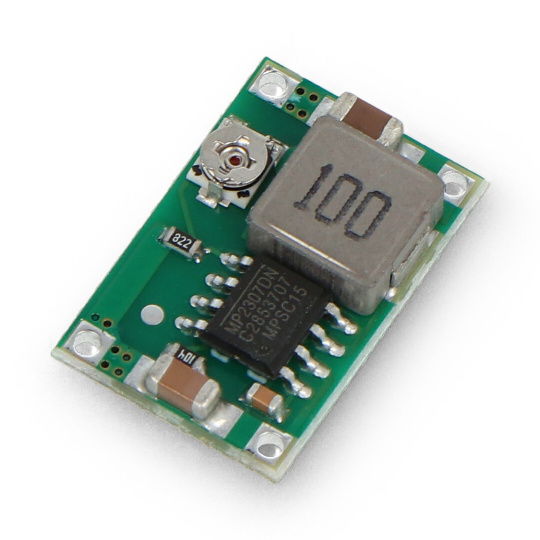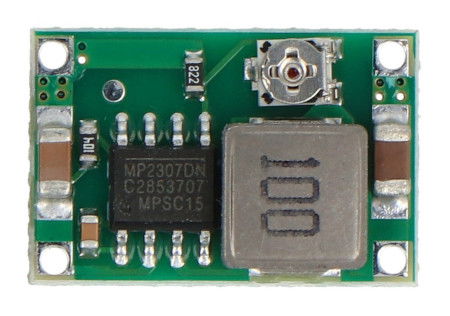Product description: D-SUN 1,0 V-17 V 1,8 A step-down converter
Step-down boost converter module. Input voltage from 4.75 V to 23 V. Maximum continuous output current 1,8 A. Output voltage adjustable from 1.0 V to 17 V.
Inverter specifications
- Input voltage: from 4,75 V to 23 V
- Output voltage adjustable within the range: from 1 V to 17 V (the output voltage cannot be higher than the input voltage)
- Maximum continuous output current: 3 A (with cooling)
- Built-in potentiometer: output voltage adjustment
- Board dimensions: 18 x 11 x 4 mm
- Weight: 2 g
Usage
The module has four leads in the form of goldpin fields:
| Pin | Description |
|---|---|
| IN+ | Input voltage - positive pole. |
| IN- | Input voltage - negative pole (ground). |
| OUT+ | Output voltage - positive pole. |
| OUT- | Output voltage - negative pole (ground). |
The output voltage is selected from 1.0 V to 17 V using a potentiometer. Note that this is a step-down circuit, so the output voltage cannot be higher than the input voltage.
Tiny DC/DC step-down converter with high efficiency
A subminiature DC/DC step-down converter module. It can operate from 4,75 V to 23 V, and its output voltage is adjustable (using a miniature mounting potentiometer) from 1 V to 17 V. The module can deliver up to 1.8A continuous current (3A with additional cooling).
The board has dimensions of 18 x 11 x 4 mm and is equipped with four soldering fields, allowing to solder pins of goldpin connectors. The module is based on the MP2307DN integrated controller.
Example of using step-down converter with Arduino
D-SUN 1,0V-17V 1,8A step-down converter is perfect for devices where there is a need to reduce the supply voltage to match the requirements of the powered device. As an example, we can mention the Arduino Uno board working with a 12V DC plug-in power supply. Although it is possible to directly connect the plug adapter to the module's DC socket, the Arduino's built-in linear regulator will inevitably overheat at higher current consumption.
To avoid this problem, you can use an inverter to lower the voltage from 12 V to about 7-8 V, which will significantly reduce the power loss of the stabilizer. Such a solution will also work for other devices powered by a linear regulator - the power lost on this circuit depends linearly on the voltage drop on it - in the example given, the converter allows to reduce the difference in voltage at the output and input of the regulator from (12 V - 5 V = 7 V) to (7 V - 5 V = 2 V).











































































































































































































































































































































